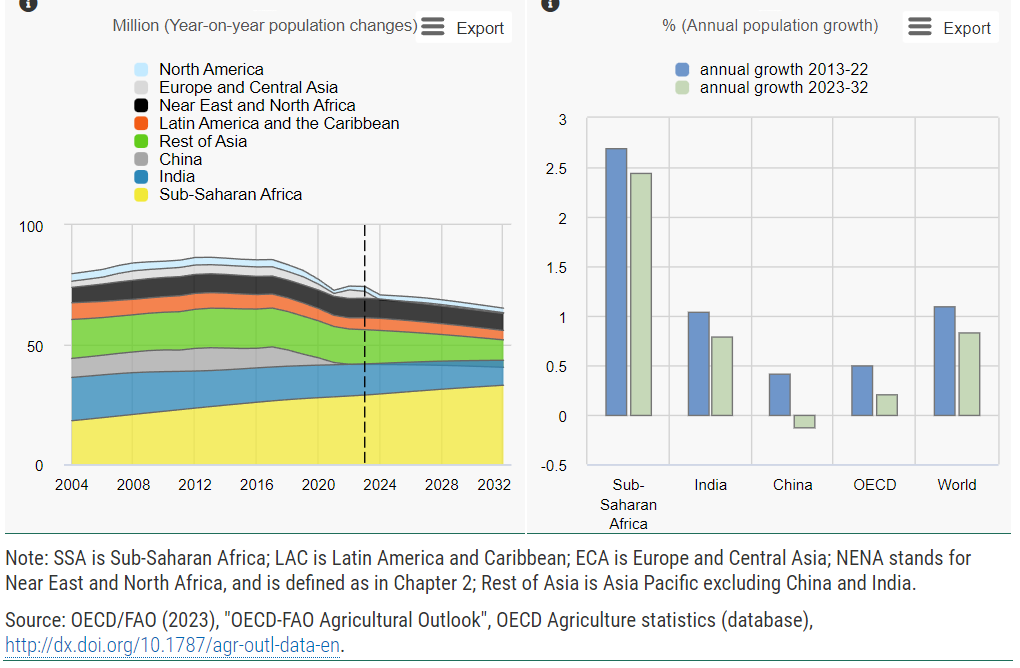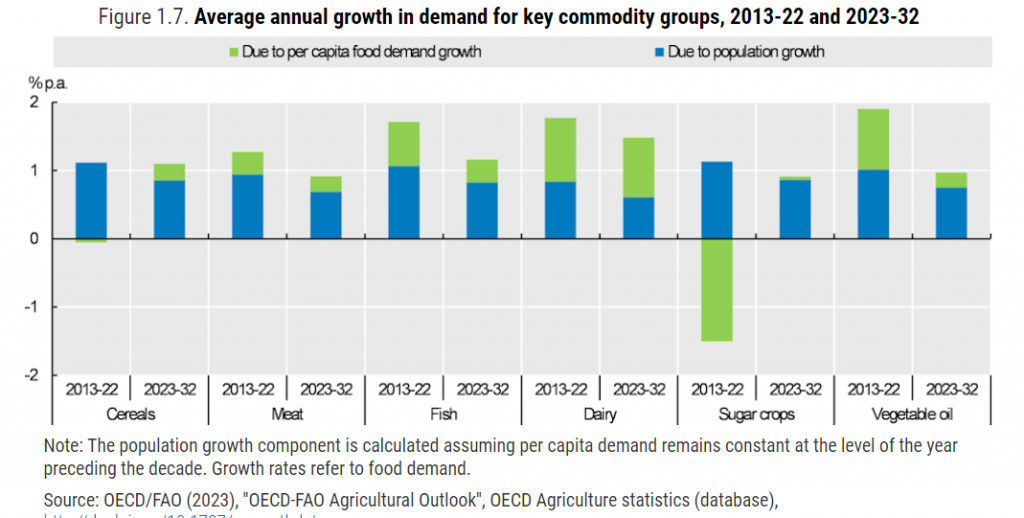
The recent surge in agricultural input prices is sounding alarm bells for global food security, warns a report jointly released by the Organisation for Economic Cooperation and Development and the Food and Agriculture Organisation. The report, titled Outlook for Agricultural Commodity Markets 2023-2032 highlights the potential impact of rising fertilizer costs on food prices.
The study employs the OECD-FAO Aglink-Cosimo modelling of production yields to distinguish between the costs of main mineral fertilizers and other production inputs. Based on this analysis, a scenario projection indicates that every 1% increase in fertilizer prices could lead to a 0.2% rise in agricultural commodity prices. The effect would be more pronounced for crops that directly rely on fertilizers compared to livestock products, excluding poultry and pig meat production, which heavily rely on compound feed.
In addition to fertilizer-related concerns, the report delves into food consumption estimates, incorporating analytical methods to measure food loss and waste. These estimates contribute to evidence-based policymaking in support of the UN’s Sustainable Development Goal (SDG) 12.3 target, aiming to halve per capita food waste at the retail and consumer levels and reduce food losses within production and supply chains by 2030.
READ I Govt raises rice supply for ethanol production amid protests by states
Food security under threat
The baseline projections in the Outlook account for the International Monetary Fund’s (IMF) October 2022 downgrade in expected average economic growth for the coming decade, as well as a decrease in China’s population since 2022. The projections assume a temporary decrease in energy prices in 2023, followed by a gradual increase until 2032. While the report considers the short-term impact of the ongoing Russia-Ukraine conflict on the agricultural market, it refrains from providing a medium-term assessment of the region’s developments.
Amid these projections, the report highlights the uncertainties posed by the war, particularly in relation to food, energy, and input prices. However, the enforcement and extension of the Black Sea Grain Initiative have helped mitigate supply issues, making grains and fertilizers more available in global markets.
World population growth


The global food consumption in terms of calories is projected to increase by 1.3% annually over the next decade. This growth rate is lower than the previous decade, mainly due to an anticipated slowdown in population and per capita income growth. The report emphasises the rapid expansion and intensification of livestock production in low- and middle-income countries, which will lead to a significant surge in demand for feed. The report projects that the growth in food demand will be driven by a number of factors, including:
Population growth: The global population is expected to reach 8.5 billion by 2032, up from 7.9 billion in 2022. This will put a strain on the world’s food supply, as more people will need to be fed.
Rising incomes: As incomes rise in developing countries, people will be able to afford to eat more meat, dairy, and processed foods. This will also put a strain on the world’s food supply, as these foods require more land and water to produce.
Changing diets: The report also notes that diets are changing around the world. In particular, people are eating more processed foods and less fruits and vegetables. This is a concern, as processed foods are often high in calories and low in nutrients.
Increased competition for land and water: The growing demand for food will put pressure on the world’s limited resources, such as land and water. This could lead to increased competition between different uses of these resources, such as agriculture, industry, and urbanisation.
The report notes that the demand for first-generation biofuel feedstocks is expected to grow gradually over the next ten years, with India and Indonesia being the main drivers of this trend. In contrast, European Union countries are expected to witness a decline in demand for first-generation biofuel feedstocks due to a shift to other feedstocks and a decrease in transport fuel use.
To maintain an overall agricultural production growth rate of 1.1% per year, the report stresses the need for investments in technology, infrastructure, and training. It emphasises the significance of increasing productivity rather than expanding land use to achieve this goal.
Regarding greenhouse gas emissions, the report warns of a projected 7.6% increase over the next decade. It highlights the urgent need for widespread adoption of climate-smart and carbon-neutral production processes and technologies, particularly in the livestock sector, which is estimated to contribute to 80% of the increase in agricultural GHG emissions.
As for international trade in agricultural commodities, the report expects it to grow in line with production over the next decade, despite the disruptions caused by the COVID-19 pandemic and the Russia-Ukraine conflict. It emphasises the importance of maintaining a well-functioning, transparent, and rules-based multilateral trading system to ensure global food security and stabilise prices.
The report acknowledges the inherent uncertainties in its medium-term projections, which rely on assumptions about current policies, consumer preferences, and production technology. It underlines that environmental, social, geopolitical, and economic developments could alter the outcomes, requiring continuous monitoring and adaptation. The report projects that climate change will have a number of negative impacts on the agricultural sector, including:
Reduced crop yields: Climate change is expected to reduce crop yields in many parts of the world. This is because higher temperatures and more extreme weather events will make it more difficult to grow crops.
Increased pests and diseases: Climate change is also expected to increase the incidence of pests and diseases. This is because pests and diseases will be able to survive in new areas and spread more easily.
Changes in water availability: Climate change is also expected to change water availability. In some areas, water availability is expected to decrease, while in other areas it is expected to increase. This will make it more difficult to irrigate crops in some areas, while in other areas it will make it easier to irrigate crops.
Technological advances: Technological advances, such as precision agriculture and genetic engineering, have the potential to increase crop yields and reduce the environmental impact of agriculture. However, the full benefits of these technologies are not yet being realised.
The OECD-FAO Outlook presents a comprehensive analysis of the challenges facing global food security and calls for proactive measures to address the impacts of rising fertilizer prices and climate change. Policymakers are urged to work collaboratively to ensure a sustainable and resilient agricultural sector in the face of evolving uncertainties.
(This article is written using AI inputs.)
